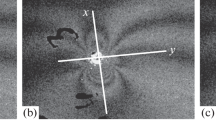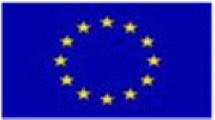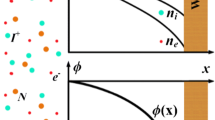Abstract
Laser welding is a common technique in the automotive industry. For economic reasons, it is of great importance to detect the defects that can appear. The CO2 penetration laser welding process is characterized by the formation of an electron-free plasma whose radiation can be measured to detect the defects. This paper presents two different approaches to defect detection. The first is based on the correlation between the power spectrum of a photodiode-generated signal and the defects. The second approach is based on the plasma electronic temperature, which is correlated to the presence of defects. Results obtained in an industrial facility under production conditions are presented.
Similar content being viewed by others
References
Sibillano T, Ancona A, Berardi V, Schingaro E, Basile G, Lugarà PM (2007) Optical detection of conduction/keyhole mode transition in laser welding. J Mater Process Technol 191:364–367
Szymanski Z, Hoffman J, Kurzyna J (2001) Plasma plume oscillations during welding of thin metal sheet with a CW CO 2. J Phys, D, Appl Phys 34:189–197
Klein T, Vicanek M, Simon G (1996) Forced oscillations of the keyhole in penetration laser beam welding. J Phys D Appl Phys 29:322–332
Klein T, Vicanek M, Kroos J, Decker I, Simon, G (1994) Oscillations of the keyhole in penetration laser beam welding. J Phys D Appl Phys 27:2023–2030
Hongping G, Duley, WW (1996) Resonant acoustic emission during laser welding of metals. J Phys D Appl Phys 29:550–555
Otto A, Deinzer G, Geiger M (1994) Prediction of weld data using process control based on surface temperature measurement for high–power energy flow processes. In: SPIE, pp 282–288
Xie J (1999) Plasma fluctuation and keyhole instability in laser welding. In: ICALEO, pp 11–20
Haran FM, Hand DP, Ebrahim SM, Peters C, Jones JDC (1997) Optical signal oscillations in laser keyhole welding and potential application to lap welding. Meas Sci Technol 8:627–633
Ancona A, Sibillano T, Maggipinto T, Ottonelli F, Lugará PM (2002) Experimental detection and theoretical prediction of laser welding plasma oscillations. In: International Workshop on detecting enviromental, industrial and bio-medical signals, pp 41–59
ISO (1997) Welding. electrons ans laser beam welded joints. guidance on quality levels for imperfections. part 1: Steel. (iso 13919-1:1996). Tech Rep, International Organization for Standardization
Zhang EY (2008) Real–time weld process monitoring. Woodhead Publishing in Materials, CRC, Cambridge
Farson DF, Hillsley DK (1996) Frequency-time characteristic of air–borne signals from laser weldings. J Laser Appl 1:33–42
Norman P, Engström H, Kaplan FH (2008) Theoretical analysis of photodiode monitoring of laser welding defects imaging combined with modelling. J Phys D Appl Phys 14(19)195502–195511
Chen HB, Li L, Brookfield DJ, Williams K, Steen WM (1991) Laser process monitoring with dual wavelength optical sensors. In: ICALEO, pp 113–122
Gatzweiler W, Maischner D, Beyer E (1998) On–line diagnostics of process–control in welding with CO 2 laser. In: Hight power CO 2 laser system and applications, pp 142–148
Miyamoto I, Kamimuki K, Maruo H, Mori K, Sakamoto M (1993) In process monitoring in laser welding of automotive parts. In: ICALEO, pp 412–423
Marson DF, Ali A, Sang Y (1998) Relationship of optical and acoustic emission to laser weld penetration. Weld J 4:142–148
Park H, Rhee S (1999) Estimation of weld bead size in co 2 laser welding by using multiple regression and neural network. J Laser Appl 3(11):143–150
Park H, Rhee S (1999) Analysis of mechanism of plasma and spatter in CO 2 laser welding of galvanized steel. Opics Laser Technology 31(2):119–126
Poueyo-Verwaerde A, Fabbro R, Deshors G, Frutos AM, Orza JM (1993) “Experimental study of laser-induced plasma in welding conditions with continuous co2 laser. J Appl Phys 74(9):5773–5780
Lacroix D, Jeandel G, Boudot C (1997) Spectroscopic characterization of laser–inducec plasma created during welding with a pulsed nd:yag laser J Appl Phys 81(10)6599–6606
Ancona A, Spagnolo V, Lugarà PM, Ferrara M (2001) Optical sensor for real–time monitoring of co2 laser welding process. Appl Opt 40(33):6019–6025
Sibillano T, Ancona A, Berardi V, Lugara PM (2005) Correlation analysis in laser welding plasma. Opt Commun 251:139–148
Sibillano T, Ancona A, Berardi V, Lugarà PM (2009) A real–time spectroscopic sensor for monitoring laser welding processes. Sensors 9:3376–3385
Alipi C, D’Angelo G, Matteucci M, Pasquettaz G, Piuri V, Scotti F (2003) Composite techniques for quality analysis in automotive laser welding. In: International symposium on computational intelligence for meassurement systems and applications. Lugano, Suiza
Basseville M, Nikiforov I (1993) Detection of abrupt changes: theory and application. Information and system science series. Prentice Hall, Englewood Cliffs
Gustafsson F (2000) Adaptive filtering and change detection. Wiley, New York
Rodríguez F, Saludes S, Miguel LJ, Aparicio JA, Mar S, Perán JR (2003) Fault detection in laser welding. In: Proc. of the SAFEPROCESS symposium, Washington
Haykin S (1999) Neural networks. A comprehensive foundation, 2nd edn. Prentice Hall, Englewood Cliffs
Griem HR (1997) Principles of plasma spectroscopy. Cambridge Monographs on Plasma Physics. Cambridge University Press, Cambridge
Mirapeix J, Cobo A, Jaúregui C, López-Aguilera JM (2006) Fast algorithm for spectral processing with application to on–line welding quality assurance. Meas Sci Technol 17:2623–2629
Author information
Authors and Affiliations
Corresponding author
Rights and permissions
About this article
Cite this article
Saludes Rodil, S., Arnanz Gómez, R., Bernárdez, J.M. et al. Laser welding defects detection in automotive industry based on radiation and spectroscopical measurements. Int J Adv Manuf Technol 49, 133–145 (2010). https://doi.org/10.1007/s00170-009-2395-y
Received:
Accepted:
Published:
Issue Date:
DOI: https://doi.org/10.1007/s00170-009-2395-y




